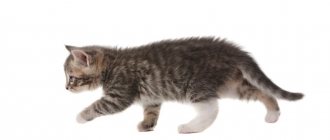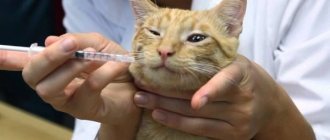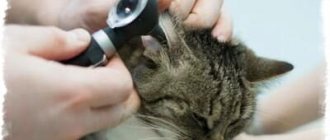Veterinarians recommend using a special filler to collect urine from cats, which is poured into a basin if it is necessary to have the urine analyzed. Alternatively, collection can be done using a urine collector or pipetting from an empty basin. To ensure accurate tests, cat litter should not be treated with chemicals or soap. Veterinarians warn that if a cat experiences severe stress due to improper urine selection, he may develop a phobia and have difficulty urinating.
Correct urine collection
If the cat constantly walks outside and the collection process is difficult, it is better to resort to catheterization at a veterinary clinic.
In other cases, it is easier to carry out the procedure on the animal at home, so as not to subject the animal to unnecessary intervention from the doctor. This is especially important when the pet is afraid of hospitals or behaves aggressively in a new environment. The most correct method would be to collect urine collected during the night in the morning.
Methods for collecting material
To obtain reliable information after taking the test, it is necessary to provide correct and comfortable conditions for collecting biological material for the cat. Therefore, there are different ways, depending on where the animal goes to the toilet:
| Place | Way |
| Tray | The cat litter box must be washed clean and the litter removed. It is possible to use a grid or mesh for trays. After the animal defecates, the contents must be poured into a special container or sterilized jar. If the cat refuses to use a tray without filler, you can fill it up, wait until the pet sits down to relieve itself, and substitute a collection container or scoop cut from a plastic bottle. In order not to waste time, you can cover the bottom of the tray with a cellophane diaper, making indentations in it, then collect the urine using a syringe without a needle |
| Sink, bathtub or toilet | The surface should be washed without cleaning agents and rinsed with water. Cover the drain with plastic wrap or a cellophane diaper, wait until the pet relieves itself, then collect the urine using a syringe and pour it into a container |
| The cat is not toilet trained | For young cats or kittens, light pressure is applied to the lower abdomen. Feeling the urge to go to the toilet, the animal begins to look for a place - then the owner must have time to substitute a tray or scoop from a plastic bottle to collect the material and pour it into the container |
Children's urine collector
A urine container is a plastic container with sticky edges made from hypoallergenic materials for adhesion to the skin and with a recess for liquid. It is used to take a test from a child, but can also be used for pets.
The device should be purchased several times at a time. If the cat does not like to feel foreign objects on itself, it is recommended to put a baby diaper on top of the urine collector so that the animal does not try to get rid of foreign objects. The procedure for collecting analysis will be as follows:
- With clean hands you need to remove the urine collector from the packaging.
- Tear off the adhesive tape.
- Place the container so that it is located between the genital organ and the anus of the pet, that is, exactly under the bladder.
- Wait until it is full, then pour the contents into the container.
Urine kit
This option is suitable for cats who are accustomed to using litter in the tray. The set is a bag with plastic granules that do not absorb liquid and a pipette. The animal mistakes the granules for filler and calmly relieves itself, after which the owner will not have any difficulty collecting urine from the cat for analysis using a pipette and pouring it into a container.
The advantage of this kit over other methods is that it is reusable. The granules can be washed and dried and then reused if necessary.
Elimination rate depending on the type of weed
The duration of marijuana withdrawal also depends on the foreign impurities that are present in it. For example, Khimka, one of the most dangerous varieties of weed, contributes to severe intoxication of the body: its metabolites settle in organ tissues and make themselves felt for a long time.
How long does cannabis stay in the blood?
People suffering from drug addiction often use cannabis, a psychoactive substance derived from hemp. Despite the fact that this is a natural substance, it contributes to the disruption of biochemical processes in the brain. The withdrawal period is from three days to three months.
How long does marijuana last?
The duration of elimination of marijuana from the body depends on a number of factors. This substance remains in urine for 21 days. In order to remove grass from the body and begin treatment for drug addiction, it is necessary to carry out high-quality and comprehensive detoxification of the body.
How long does the plan last?
The plan contains cannabinol, which concentrates in the blood over two weeks. The psychoactive substance contributes to intoxication of the body, disturbances in heart rhythm and activity of the central nervous system. To cleanse your body of weed, go to a drug treatment clinic.
How long does hemp come out?
The withdrawal period for cannabis is quite long and can reach three months. Some people required to take a drug test try to cheat by using diuretics. Such attempts will not be successful: if the concentration of the main components of urine is reduced, the test results will be invalid. Don't try to avoid responsibility for your drug use and begin comprehensive addiction treatment.
How many days does hashish last?
Smoking hashish not only contributes to complex intoxication of the body, but also affects the functioning of the respiratory system. Resins accumulate in the lungs, which can later lead to bronchiectasis and oncology. The duration of elimination of hashish from urine ranges from 21 to 91 days: the exact indicators depend on a number of factors.
Using a tray
If the container is without filler, it will do just fine. A cat litter box with a grid is one of the most convenient options, provided it is used correctly. The first step is to wash it thoroughly to prevent bacteria that live on its walls from getting into the urine. To do this, use laundry soap, hydrogen peroxide or chlorhexidine.
There is another method that can be successfully used. You also need to keep an eye on your pet. As soon as the cat sits down and begins to urinate, they immediately grab him by the scruff of the neck, lift him up, and fill the bowl with urine. I must say that the method is far from the best. It poses a risk of negative side effects, the main of which are the following:
Difficulty urinating due to severe stress. Such conditions do not always pass without leaving a trace. The cat may stop going to the litter box out of fear of being grabbed again. In this case, puddles will appear throughout the house. Bladder spasms may occur due to surprise.
Here it is important to take into account the character of your pet, how timid he is.
We invite you to read: Joint dysplasia in cats: what it is, types of the disease, causes of development, first signs, treatment, consequences of the disease
By the way, today there are a lot of models of trays. Breeders praise the toilet - a house for the cat, where he feels very comfortable. These models are the most convenient for placing a bowl to collect urine without your pet noticing anything.
How to take a urine test from a cat?
When a cat experiences health problems, it is often necessary to have their urine collected for testing. In such a situation, the owner needs to know how to collect urine from the cat for analysis. A similar study is necessarily carried out when there is a suspicion that the cat has urolithiasis. In this case, urine can be donated more than once. When examining a dog, such an analysis is not often required otherwise, so the experience of a dog breeder will not help here.
If possible, the veterinarian tries to do this
He carefully squeezes the contents of the bladder into a special tray. If the attending physician carries out the collection while on call at the pet's home, the urine can be collected in a special bag and delivered to the laboratory in it.
The owner has to collect urine at home when, for some reason, a specialist was unable to carry out such a procedure. Most often, this phenomenon is due to the fact that the cat at the time of admission to the clinic had a completely empty bladder or, on the contrary, there was stagnation of urine, from which the contents of the bladder were already infected. If the clinic collected urine with a catheter, this indicates the need for urgent research. This method is not applicable at home.
When does a cat need a urine test?
As a rule, a urine test is not prescribed for no reason and aims to discover the cause of painful changes in the pet’s behavior. Such changes are somehow related to bladder emptying:
- The cat often visits the litter box, but his visits remain fruitless. This may indicate a blockage of the urinary tract or kidney failure and requires prompt medical intervention.
A cat's unsuccessful visits to the litter box are a cause for serious concern.
- The cat meows loudly while emptying its bladder. This symptom indicates possible inflammation of the kidneys, urethra, etc...
- The cat's urine has changed color and contains pus or blood. Normally, the color of cat urine should be light yellow; if it changes to deep amber, you should be concerned about the health of the animal. Blood in the urine, in turn, is a possible sign of stone damage to the urinary canal.
- The cat's urine began to smell sharp. In a healthy cat, urine does not have a pronounced odor; its presence may be a consequence of the proliferation of bacteria in the animal’s genitourinary system.
The repulsive smell of your pet's urine indicates a change in its composition
- The cat began to ignore the litter box and now relieves himself in places that were previously unusual for him. The reason for this behavior is sometimes not harm, which is the first thing that comes to mind, but the inability to control urges due to incontinence.
How to collect urine from a cat for analysis
Cats are susceptible to diseases of the kidneys and urinary system, so each owner may be faced with the need to collect urine from a cat for analysis.
The veterinarian will write a referral for testing without hesitation, but owners often have difficulty collecting a sample.
There are several ways to obtain a urine sample from a cat.
Cystocentesis
If you need to donate urine for bacterial culture, then the only sure way is to collect it using cystocentesis. To put it simply, through a puncture (puncture) of the bladder. The procedure is performed by a veterinarian using a sterile syringe.
Although owners may be wary of a needle penetrating their pet's abdomen, cystocentesis is a safe and simple procedure that is performed without anesthesia. If the doctor finds it difficult to find the bladder (low filling, abdominal wall tension, severe obesity), the injection is performed under the control of an ultrasound sensor.
Catheterization
Collecting urine through a urethral catheter is important for males, but placing a catheter in a cat is extremely difficult (general anesthesia is required). This technique is inferior to cystocentesis in all respects:
- insertion of a catheter can be painful and some cats require general anesthesia;
- the catheter serves as a gateway for infection and further irritates the urethra, causing inflammation.
But catheterization is sometimes necessary on its own - when the cat cannot urinate (the urethra is clogged with a plug, sand or stone). Then you can send urine taken through a catheter for analysis - if there is not too much blood in it.
Collecting from a tray
When urine needs to be taken several times in a row (for example, to evaluate the result of antibiotic treatment), owners do it at home themselves.
Urine should be free of foreign matter (filler, wool, dirt);
- The sample must be delivered to the laboratory within 2 hours (so you will have to guard your pet and wait for him to pee);
- The volume is at least 5 ml, and better - from 20 ml.
Depending on the cat’s habits, two options are possible:
If the cat is used to going to a tray with a grid or does not mind peeing once in a tray without filler, there are no problems. It is enough to thoroughly wash the grate and trough and pour boiling water over it. Do not use strong detergents; soda or laundry soap is enough, after which the container must be thoroughly rinsed and dried.
Immediately after urination, urine is collected with a syringe without a needle or simply poured into a sterile container for analysis.
If a cat cannot go to the toilet without rummaging around in it, you have to resort to tricks. The tray is prepared in the same way as in the previous case. Then you need to make it attractive to the cat.
The easiest option is to buy a special “Urine Collection Kit”. These are plastic granules that imitate filler, but do not absorb liquid. In order to fill the tray you will need at least 3 bags, but the granules can be used many times (wash in a colander, dry, put away until next time).
If such kits are not commercially available, you can use polystyrene foam, dividing it into balls, small expanded clay or aquarium pebbles - any material that will not absorb urine.
You can also try making a hole in the usual filling and covering it with cling film. If the cat pees, the urine will accumulate in the cavity and can be easily collected with a syringe. The main difficulty is to get the patient out of the tray before he starts digging.
Bath/toilet collection
Some cat owners are real magicians: they teach their pet to go to the real toilet or to the bathtub. And in fact, this is not a problem in terms of collecting urine - just repeat the trick with cling film/plastic bag. The drain is covered with a film (with a recess!), you can secure it with tape.
The Zootopia channel wishes your pets good health!
https://www.belanta.vet/vet-blog/sposoby-sbora-mochi-u-koshki-dlya-analizov/https://veterinargid.ru/cats/vet/kak-sobrat-mochu-u-kota- na-analyz.html
When is it necessary to collect analysis?
Frequently collecting urine for examination is not recommended; this must be done as prescribed by a veterinarian. However, it is better for the owner to know when unwanted changes occur in the cat. First of all, they can be seen by a change in habitual behavior. If an energetic cat lies down all the time, then the owner better pay attention to the pattern of urination. A change in the frequency of visiting the toilet and the amount of fluid secreted is a reason to visit the veterinarian and collect urine for testing.
Collecting urine for research is a real problem for many owners; if a pet lover applies a little patience and ingenuity, then this problem can be solved in a variety of ways.
Cat urine analysis: how to store and transport urine for research
The best option is to conduct urine tests on cats no later than half an hour after receiving a portion of urine.
But, more often than not, this is impossible and a large amount of time must pass before the examination. Therefore, the study is carried out later, and the collected urine should be stored in a container in a cool place
.
This can be explained simply. 2 hours after collection in urine
the growth of pathogenic flora, including staphylococcal flora, begins. In addition, after such a period of time, the acidity level in the urine changes, the cellular inclusions of the sediment are destroyed, and other biochemical and chemical changes occur that distort the results and the interpretation will be incorrect. If the urine is too cooled before the study, this will lead to the phenomenon of crystallization in vitro, that is, it will significantly enhance the process of crystallization of the cat’s urine. To preserve urine for a long time before analysis, you need to add a special preservative to it.
It can be taken from a laboratory for the study of biomaterials and has a very low cost, accessible to almost everyone.
It is necessary to tell the owners of clawed pets that it is recommended to take tests regularly
at least once every six months. This is due to the fact that cats suffer from certain diseases with subtle symptoms. For example, a neutered cat has an increased risk of developing urolithiasis. And this disease must be prevented by changing and adjusting the diet. And other diseases, more often of a metabolic nature, occur more often in castrates. This fact is a reason to think carefully before deciding to castrate your pet.
In kidney diseases, the presence of staphylococcus is most often noted, and urine analysis shows
how severe the disease is. There are a huge number of diseases identified by urine. And only one analysis can give a clear picture of the state of the body of your beloved cat.
If you find an error, please select a piece of text and press Ctrl+Enter.
Why collect cat urine: the importance of urine testing
Testing your cat's urine is an inexpensive, simple, and non-invasive procedure. What is this for? In fact, your cat's urine can provide your veterinarian with a lot of information about her health.
First, it needs to be analyzed if you suspect kidney stones in your cat. The test essentially checks the pH of the urine and the possible presence of crystals. In addition, it can also help identify urinary tract inflammations such as cystitis.
© shutterstock
Collecting and testing a cat's urine sample can also be used to determine the presence of diabetes by checking blood sugar levels. Finally, it helps assess kidney and liver function, allowing you to quickly identify any pathologies affecting these organs.
How to properly collect urine
If urine collection is done at home, then for analysis it is better to use a portion of urine that accumulates in the bladder over a long period. Therefore, the best time to collect urine is in the morning. This eliminates daily fluctuations in indicators and more objectively characterizes the parameters under study.
Urine should be collected in a plastic, disposable urine container with a tight-fitting lid. It is best that the container is sterile. Urine samples in randomly adjusted and poorly closed containers may become contaminated during storage, which leads to changes in the physicochemical properties of urine. Using disposable plastic containers with screw caps avoids most negative changes in sample storage. You can always get such a container for free from your doctor and laboratory, or you can buy it at a regular medical pharmacy.
If you have a male dog, then you need to take a container for urine and a second person – an assistant – with you outside. One person holds the dog on a leash, and the second, at the time of urination, places an open container under the stream of urine and takes a medium portion of urine. After this, the container must be immediately tightly closed with a lid and delivered to the laboratory for research within 1 hour.
If you have a bitch, then you first need to prepare a flat tray at home for collecting urine. It should be washed thoroughly without detergents, rinsed well, and doused with boiling water. When going outside, you need to take with you a prepared tray, a container for urine and a second person – an assistant. One person holds the dog on a leash, and the second, at the moment of urination, places a tray under the stream of urine and takes away the average portion of urine. After this, the urine should be poured into a container, the lid should be tightly closed and delivered to the laboratory for testing within 1 hour.
If your cat uses a litter box: empty the litter tray, wash it thoroughly without detergents, rinse well, pour boiling water over it and place it in its usual place. You can put a clean, thick plastic bag on top of the filler, previously washed and scalded with boiling water, and make several depressions in the filler into which the urine will drain. Observe the cat and immediately drain the urine into a prepared container, close the lid tightly, and transport it to the laboratory for testing within 1 hour.
If your cat has used a sink or bathtub as a toilet: clean the sink/tub without using household chemicals, rinse it thoroughly with running water and cover the drain with clean food packaging film so that a depression is formed at the drainage site. You can take a disposable clean bag and cut off a corner of it so that you get a cone, the base of which is slightly larger than the diameter of the drain. Monitor the cat and immediately drain the urine into a container, close the lid tightly, and take it to the laboratory for testing within 2 hours.
Remember that traces of detergents and other household chemicals change important characteristics of urine.
For analysis, at least 5-10 ml of urine is needed, but 20-100 ml is better, since diagnostically important cellular elements may not be included in a small amount of urine. Urine must be delivered to the laboratory immediately after collection. The study must be carried out no later than 2 hours after receiving the material. When urine is stored for a long time in light and heat, the destruction of cellular elements occurs, which leads to false negative results.
Urine can also be obtained directly in the clinic through bladder puncture or catheterization.
What if the cat is used to going to the bath?
If your cat has developed the habit of going to the toilet in the bathtub or sink, then you need to clean them with a brush and rinse with water. Then cover the surface of the bath with cling film so that there is a depression at the drainage point. As soon as you notice that the cat has gone to the toilet, you need to draw the contents into a syringe with a previously removed needle. Then pour the urine into a collection container.
The bathtub, sink or tray should not be washed with detergent, as it may distort the main characteristics.
How to collect urine from a tray
After the cat goes to the toilet, the urine can be poured into a plastic container.
If the cat is used to relieving itself in a litter box, the owner can try collecting urine from it. For this purpose, the tray should be freed from the filler, washed with hot water and wiped dry. After the pet goes to the toilet, the biomaterial can be poured into a special plastic container or a clean, dry jar.
The problem with this method is that cats often refuse to urinate in a litter box without litter. In this case, the cat's litter box can be filled with small pieces of toilet paper or Styrofoam balls. These materials do not absorb liquid and after your pet visits the toilet, urine can be collected with a syringe or pipette.
If the cat refuses to urinate in a tray without litter
Before collecting urine from the tray, it must be washed clean.
What to do if your pet flatly refused to go to the litter box without the usual litter? Just watch for the moment when the cat wants to go to the toilet. When the animal sits down in the tray to urinate, you should place a previously prepared clean container under the stream. Some owners lift the pet by the scruff of the neck for this purpose, but this is not recommended.
The cat may get scared and stressed, and this will lead to the fact that she will be afraid to go to the toilet and will continue to leave surprises in the form of puddles throughout the apartment.
How to Collect Urine from a Toilet or Sink
Before collecting urine, the toilet bowl should not be cleaned with detergents.
Some owners teach their pets to relieve themselves in the sink or toilet. In this case, urine can be collected using the following method.
- The toilet or washbasin must be thoroughly washed with a brush or sponge, then rinsed with hot water.
- The next step is to line the recess with cling film or a plastic bag so as to completely cover the drainage area.
- All that remains is to wait until the cat goes to the toilet and collect the urine with a syringe.
Special urine collector for cats
A special means for collecting urine.
Veterinary pharmacies began selling special collections for urine from cats.
Collecting urine using a urine collector
But what about those owners whose cats roam freely and relieve their needs on the street? They can collect their pet's urine using a child's urine collection bag.
Children's urine collector.
A urine collector is a plastic container with sticky edges and a recess for collecting liquid. To use this accessory, a certain skill is required, so it is advisable to purchase several copies at once, since you may not achieve the result the first time.
How to use a urine collector for a cat
Before removing the urine collection bag from the sterile packaging, you should wash your hands with soap and water. Remove the protective adhesive tape from the item. Glue the accessory onto the pet so that the container for collecting urine is located exactly under the cat’s bladder and does not touch the anus. Wait until your furry pet urinates, carefully separate the urine bag from it and pour the urine into a prepared, clean container.
Before removing the urine container from the packaging, you should wash your hands with soap and water.
If the cat goes to the toilet on the tray
Rinse the cat litter well with laundry soap and running water. Pour boiling water over it. Do not use household chemicals, as chemical components may remain on the surface, which will lead to errors in analysis.
Place clean cellophane on the bottom of the tray tray. If the cat is afraid of rustling objects, place a plastic mesh on top.
As soon as the pet has done its business, collect the urine with a syringe or pipette into a pre-prepared container.
How much blood should be taken for analysis?
You should not think that the more blood you take, the better. The fact is that blood for different types of tests is collected in special tubes containing additional substances (clotting activators, if we are talking about a biochemical analysis, or clotting inhibitors, if we are talking about a clinical analysis). There are test tubes of different volumes, where the amount of additives is calculated for a blood volume not exceeding the value indicated by a special mark.
The use of modern automatic analyzers allows us to minimize the volume of serum required for analysis. The analytical parameters of our analyzers allow us to work with 5-10 μl of serum, and to carry out analysis for 17 indicators, we only need 230 μl of serum (about 1.5 ml of whole blood). This allows you to minimize pain when taking blood, especially from small animals (cats, hamsters, some breeds of dogs, etc.).
How to collect samples for testing from domestic cats and dogs?
In order for laboratory test results to be reliable, you must correctly collect a urine sample from your pet.
Collecting urine from cats
Biomaterial is collected from feline representatives at any time of the day. There are several simple and proven collection methods. The choice depends on the habits of the pet itself.
- a tray with a grid insert is the most convenient method for the owner if the animal is accustomed to a tray with a grid without filler. You just need to rinse it first and dry it with a clean, moisture-wicking cloth. Do not use foaming detergents to clean the tray. It is better to treat the surface with hydrogen peroxide or laundry soap. After the pet has emptied, the material is poured into a special sterile container, closed and delivered to the laboratory for analysis;
- box with filler. If your cat is used to emptying into a litter tray, you can use white office paper, new aquarium soil, or foam balls. They do not absorb moisture and do not have dyes. Urine is collected from the corner of the tray with a syringe without a needle;
toilet, bathtub, washbasin. Some pets are trained to urinate directly into the toilet or bathtub. Then the animal owner must first thoroughly rinse the surface of the toilet bowl and lay cling film on top so that it completely covers the drain. Then, after visiting the animal, collect biomaterial with a syringe;
To collect urine from the toilet you will need improvised means
specialized urine collector for cats.
Cat urine collection agent
Collecting urine from dogs
Urine collection from dogs is done in the morning. The container must be prepared in advance: washed and disinfected.
collection during free urination. Discharge samples are collected during a morning walk. For male dogs, you need to prepare a plastic bottle (suitable for mineral water or oil). Cut off the lower half, and rinse and disinfect the upper half with the lid well.
Collecting urine while walking depends on the gender of the pet
For females, take a tray with low sides or a cup. Don't forget to take a sterile urine container and disposable gloves. The dog is held on a short leash, located slightly behind it. At the right moment, a container is placed under the stream. It is better to take a medium portion of urine. To pour into a container, simply unscrew the cap of the bottle;
collecting from a tray. It will not be difficult to take the material from litter box trained dogs. You just need to disinfect the container in advance.
A children's urine bag, which can be purchased at any pharmacy, is quite suitable for dogs.
Below are the simplest ways to do this:
- If your dog urinates in the same place every time, you can put a clean film in advance and then collect the result with a syringe;
- You can use a urine bag for children. To secure it to the body, use diapers or accessories for dogs (overalls, pants, bodysuits)
Below are additional tips on how to collect urine from your pet on the street without causing resistance.
Collection of tests on the street
If you have difficulty taking samples at home, you can seek help from specialists. In veterinary laboratories, urine collection may be done using a catheter. However, this method has a number of disadvantages: pain, the need for fixation, trauma and contamination in males. Therefore, this method is used for emergency purposes.
A catheter is used only in extreme cases, as it can threaten the health of the dog
The most sterile and informative method is cystocentesis - puncture of the bladder with a syringe. This manipulation is performed by a doctor. The procedure is painless and is done in a position that is comfortable for the animal. Sometimes cystocentesis is done under ultrasound guidance.
Cystocentesis procedure
How is urine taken for examination in a veterinary clinic?
If you need to collect research material, but this cannot be done at home, then it is better to seek help from specialists. Most often, the veterinary service takes a puncture from a pre-filled bladder. Do not be afraid of this procedure if it is performed by a specialist. Puncture is a low-traumatic operation. To do this, the cat is placed on its back and a 20 ml syringe is injected into the area below the navel. This procedure is especially important for bactericidal analysis, as it will give the most accurate result. The puncture is a safe and painless process and is called cystostomy. The veterinarian performs catheterization less often, as it is more dangerous and traumatic for the animal.
Choosing a urine collection container
The correct choice of container for urine is of great importance for objective analysis. For this purpose the following can be used:
Disposable urine containers sold in pharmacies
They are inexpensive and close tightly (which is especially important for transporting cat urine). In addition, such vials are completely sterile, which ensures complete reliability of the analyzes.
Glass medicine bottles
It is quite acceptable to use them, but such containers should be properly prepared before use. To do this, wash the bubbles thoroughly with warm water and soap or soda, and then boil for 10 minutes. After this, they are thoroughly rinsed with settled boiled water.
Reasons why pollakiuria may occur
The reasons why a cat begins to visit the toilet frequently, and urine output is insignificant, can be pathological and physiological. In the first case, the animal requires treatment, and in the second, the phenomenon is considered normal and should not cause concern.
If the owner cannot independently understand whether the animal is sick or not, consultation with a veterinarian is required, and urgently.
Be sure to read:
Diarrhea in a kitten: what to do, first aid, causes, treatment, medications and folk remedies
Many diseases of the bladder, kidneys, and metabolic diseases can be treated quite effectively, but if detected at an early stage. Some pathologies are chronic and the animal requires regular maintenance therapy.
What is cystitis and why does it appear?
The main reason for frequent visits to the toilet, when there is little urine left in the tray, and sometimes it is mixed with blood, is cystitis. This inflammatory disease of the bladder does not occur without provoking factors.
Cystitis occurs as a primary pathology or complication. Depending on this, the necessary therapy is determined.
The development of cystitis in cats can be provoked by:
- disturbance of metabolic processes in the body (most often observed in old animals);
- suffered a severe infection;
- the presence of stones and sand in the kidneys, ureters or bladder;
- disturbance in mineral balance;
- improper nutrition, in which the cat does not receive enough proteins and fluids;
- infection of the genitourinary system;
- pregnancy and childbirth (cystitis can occur as a complication);
- cold.
Abdominal injuries can trigger the development of cystitis in a cat. This phenomenon is more typical of animals that have free access to the street, but can also be observed in apartment pets during unsuccessful jumps from a height.
The main reason for frequent visits to the toilet is when there is little urine left in the tray, and sometimes it is mixed with blood
With cystitis, a cat not only experiences frequent urination, but also meows when going to the toilet, as the process is accompanied by pain. Due to pain, the pet's behavior when trying to touch its stomach becomes aggressive.
Urolithiasis disease
Urolithiasis occurs in most older pets and some young ones. The risk of pathology in neutered cats that receive improper nutrition increases slightly. In this case, the owners themselves are to blame for the fact that the animal begins to get sick.
For neutered pets, you should use only special ready-made food or coordinate their natural diet with a veterinarian.
Stones not only injure the mucous membrane, causing irritation and inflammation, but also lead to blockage of the ureter, which impairs the flow of urine. If urine stagnation occurs and the cat does not receive emergency treatment, it dies within a few days.
At the same time, the general condition of the animal worsens. A complete lack of urination is an emergency condition when you cannot postpone a visit to the veterinarian even for a day.
Be sure to read:
A cat is vomiting yellow liquid: normal or pathological, first aid, what to do, best medications, diet
Urolithiasis develops slowly. First, sand deposition begins in the kidneys. It does not interfere with the flow of urine and rarely causes any symptoms. Remaining in the kidneys, sand becomes compacted over time, and stones begin to form.
Fractions increase gradually. Small in size, they pass through the ureters and are partially removed in the urine. If treatment is not started at this stage, the stones will enlarge and cause health problems for the pet.
Does an IV help remove THC?
A drip is one of the most popular and effective ways to remove tetrahydrocannabinoids from the body. The infusion of infusion solutions has a quick and complex effect. A specialist can use water-salt solutions, antihypertensive drugs, vitamin-mineral complexes and much more: this helps to cleanse the body and carry out symptomatic therapy.
The benefits of IV drips for the recovery of a drug addict’s body are invaluable:
- Acceleration of metabolism, enhanced removal of toxins from tissues;
- Cleansing the bloodstream from anasha metabolites;
- Replenishment of circulating blood volume;
- Fighting dehydration;
- Normalization of water-salt balance;
- Quick and effective treatment of acute pathologies that have developed as a result of drug use (hypertensive crisis, psychosis, liver disease, etc.).
It is important to note that infusion should only be carried out with the participation of experienced specialists. Attempts to independently insert an IV lead to anaphylactic shock, Quincke's edema, vascular air embolism, local necrosis and extensive subcutaneous bruising. Don’t risk your health and entrust medical procedures to specialists.
How to remove THC from urine
When thinking about how to remove cannabinol from urine, you should consider the general principles of detoxification of the body. Droppers, sorbents, and some hardware techniques (UBI, electrical stimulation, acupuncture, electrophoresis, etc.) are very effective.
Taking diuretics to cheat a drug test is not only ineffective, but also dangerous: it can lead to dehydration and severe kidney damage. You can take a drug test anonymously: the data obtained is not shared with law enforcement agencies, since the results are considered preliminary.
How to remove cannabis from the blood
In order to remove weed from the bloodstream, you need to contact a specialist. Changing the drinking regime and taking sorbents does not bring tangible results: only comprehensive medical care can restore the functioning of internal organs and cleanse the bloodstream of psychoactive substances.











